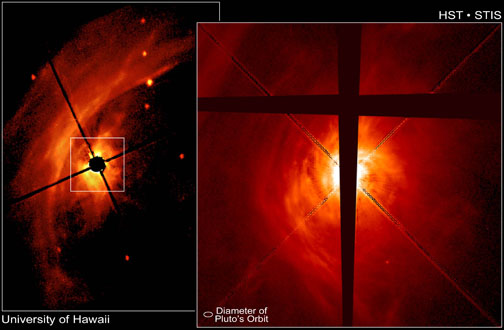
|
Viewing a protoplanetary disk from above is complicated by the blinding light from the star. Fortunately, astronomers can block out this light to see dimmer objects next to the star. The black and reddish crossed lined in the images above are artifacts of this light-blocking process. The image on the left is the best available ground-based telescope image of the developing star AB Aurigae and its planetary disk. The big arch of reddish material outside of the white box is part of a molecular cloud from which AB Aurigae (blocked out) and its disk presumably formed. To give you a sense of scale, the central blocked out circular area is nine times larger than our own Solar System. The image on the right is a Hubble close-up of the planetary disk around the star (see white outline in left image). The blacked out bar over the star is about 1.4 times the size of our Solar System. Thus, the large orange and reddish planetary disk is HUGE compared to our Solar System. The disk shows interesting structures, including spiral shaped bands that are most obvious to the left and upper right of the star and broad brighter knots visible especially to the left of the star. The spiral bands suggest that the cloud is in some sort of developing orbit around the star. The knots to the left may represent the first stages of planetary growth in the disk. There is one bright point to the lower right; it is a star behind the disk, not a planet. Now you have some idea of what our Solar System may have looked like just as it was starting to form and take its first steps toward developing planets. The next step is to take a tour of our Solar System to see how things turned out after 4.55 billion years of time. We're skipping a lot, including potentially major changes in the orbits of some of the planets, but this site isn't intended to replace a good textbook. The goal is for you to recognize and identify natural features on sight! Image credit: Hubble Space Telescope; The main source for HST images and explanations is HubbleSite.org. |
|
|
|
